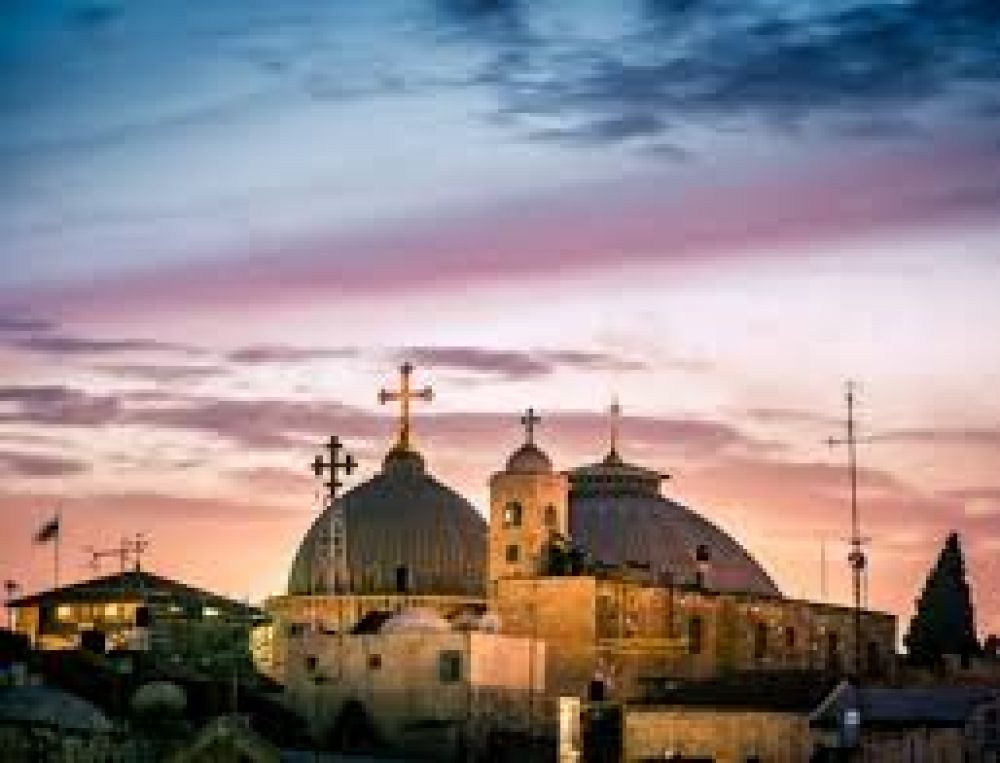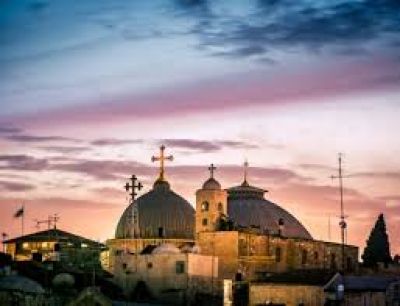

Participate in a comprehensive guided tour of the Church of the Holy Sepulchre, a site of immense religious significance, believed to be the location of Christ's crucifixion, burial, and resurrection. As you enter through the historic doors, you'll be engulfed in its spiritual ambience and architectural magnificence. Your knowledgeable guide will explain the church's complex history, point out significant artifacts, and navigate through the various chapels and sanctuaries, including the Stone of Anointing, the Calvary, and the Aedicule, which houses the Holy Sepulchre itself. Witness pilgrims from around the world paying homage, and learn about the church's administration, shared by several Christian denominations. This profound experience is a must for those looking to connect with Christian history and the profound events commemorated here.
Experiencing a religious service at the Church of the Holy Sepulchre offers a unique opportunity to observe the traditions and rituals that have taken place on this hallowed ground for centuries. With masses conducted by various denominations having custodianship over the church, including Roman Catholic, Armenian Apostolic, and Greek Orthodox services, participants can witness the diversity of Christian liturgical traditions. The atmosphere during a mass is imbued with devotion and reverence, augmented by the church's acoustics that resonate with choral hymns and prayers. Attending mass is not only a spiritual occasion but also a chance to appreciate the shared beliefs and different practices amongst the Christian congregation gathered from around the globe. It is a peaceful activity that connects believers more deeply with their faith.
For those looking to physically retrace the steps of Jesus, climbing the steep and narrow staircase to Golgotha, also known as Calvary, is an activity of great significance. At the top, situated within an ornately decorated chapel, are the Rock of Calvary and the Altar of the Crucifixion. Here, pilgrims kneel to venerate the exact spot where it is believed the Cross of Jesus was erected. This intense and moving experience allows visitors to contemplate the events of Good Friday in a direct and tangible way. Feeling the coolness of the rock through a special opening beneath the altar, many find a deep spiritual connection and moment for personal reflection on the sacrifice made at this spot, as recounted in Christian scriptures. The climb, though short, is steep and can be crowded, requiring patience and careful footing.
Lighting a candle is a long-held tradition for visitors to the Church of the Holy Sepulchre. It symbolizes prayers and remembrance, as well as the light of Christ. Upon entering the church, you'll notice many stands filled with candles lit by worshippers. Visitors can purchase a candle inside the church and find a spot to light it, often near one of the many chapels or in front of the Stone of Anointing. As the flame flickers and rises, it joins the myriad of other lights representing the collective hope and devotion of those who have journeyed here. This simple act ties the individual pilgrim to the community of believers and to the sanctity of the church itself. It is a quiet moment for prayer and meditation, allowing for personal reflection within the busy atmosphere of this sacred space.
The Church of the Holy Sepulchre is not only a singular shrine but a complex of numerous chapels, each with its distinctive history and significance. Exploring these sacred spaces, you’ll uncover a mosaic of traditions that compose the rich tapestry of Christian heritage. Venture into the Chapel of Saint Helena and descend further to the Chapel of the Finding of the Cross, where the True Cross was said to be discovered by Saint Helena. Visit the Chapel of the Angel, where an angel is said to have announced Christ's resurrection. Each chapel has a story; through the intricate iconography and the ambiance of these intimate spiritual spaces, visitors gain insights into the historical and theological threads that weave together to form the church's revered narrative. This activity is as much about exploration as it is personal pilgrimage, appealing to history enthusiasts and faithful pilgrims alike.
Participating in the Holy Fire ceremony is a unique and deeply spiritual experience for Orthodox Christians and observers alike. This annual event occurs on the day preceding Orthodox Easter, where thousands flock to witness the miraculous appearance of the Holy Fire. The ceremony symbolizes Jesus Christ's resurrection, and the church fills to the brim with anticipation. When the Patriarch of Jerusalem enters the tomb, a hush falls over the crowd, waiting for the fire to emerge. Upon the Patriarch's exit, flames are rapidly shared among the faithful's candles, illuminating the darkened church in a matter of seconds. The radiance of the fire and the shared joy and excitement are palpable. Visitors are advised to arrive early to secure spots and to be ready for an experience that is both intense and awe-inspiring. Security is tight, and movement within the church is restricted during the ceremony, so plan accordingly.
Attending one of the solemn processions conducted by the various Christian denominations within the Church is to witness a living tradition that has been passed down through the ages. These processions often occur in the early morning or evening and include prayerful chants, the carrying of religious icons, and ceremonial incense, all of which create a profound multisensory experience. Observing or joining these processions allows visitors to engage with the faith and traditions of the Christian communities responsible for the church. It's an encounter that fosters a deep appreciation for the shared heritage and the peaceful coexistence amidst diversity. Whether participating actively or watching respectfully from the sidelines, the processions are a moving reminder of the enduring spiritual legacy of the Church of the Holy Sepulchre.
A visit to the Church of the Holy Sepulchre can also be a fascinating journey for architecture and art enthusiasts. The church's design is a patchwork of styles that span centuries, a testament to the multiple rebuilds, renovations, and additions the building has seen. Take time to study the grandeur of the domes, the ancient stone columns, and the ornate details that adorn the walls and ceilings. Particularly noteworthy are the exquisite mosaics depicting biblical scenes and early Christian symbols that adorn some of the chapels. These mosaics are not just decorative elements, but a visual retelling of Christian history, crafted with skill and devotion. Exploring the church with an eye for artistic detail will reveal a rich tapestry of cultural and spiritual significance, offering a greater understanding of the church's importance beyond its religious context.
Photography enthusiasts will find the Church of the Holy Sepulchre a challenging yet rewarding subject. The interplay of light streaming through the windows with the shadows of the ancient architecture creates a unique atmosphere that is both haunting and beautiful. Capture the ethereal rays illuminating the incense-filled air, the intricate patterns on the chapels’ iconostases, or the diverse tapestry of pilgrims in prayer and contemplation. Though the low light conditions require skill and patience to navigate, the church offers endless opportunities for stunning photography. It's essential to be respectful of the sacred nature of the site and of worshippers when taking photos, avoiding use of flash and intrusive actions. This creative endeavor is not just about taking pictures, but about immortalizing a moment of profound historical and spiritual significance.
The Stone of Anointing, also known as the Stone of Unction, is believed to be the spot where Jesus' body was prepared for burial after his crucifixion. For visitors interested in religious practices and rituals, witnessing or participating in a ceremony at this sacred location can be a poignant experience. Pilgrims often kneel to kiss the stone, drape it with cloths or objects to be blessed, or anoint it with oils and perfumes. These acts are performed with deep reverence and symbolize the connection between the pilgrims and the sanctity of the events commemorated in this place. Attending a ceremony here is not only an expression of faith but also an opportunity to observe the diverse ways in which the faithful engage with this hallowed spot, each gesture imbued with personal significance and historical continuity.
